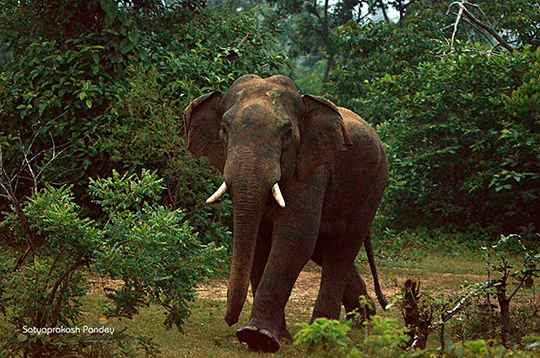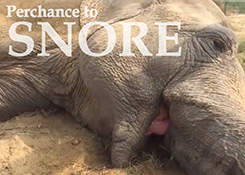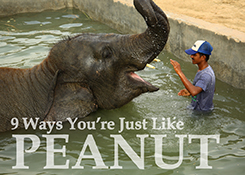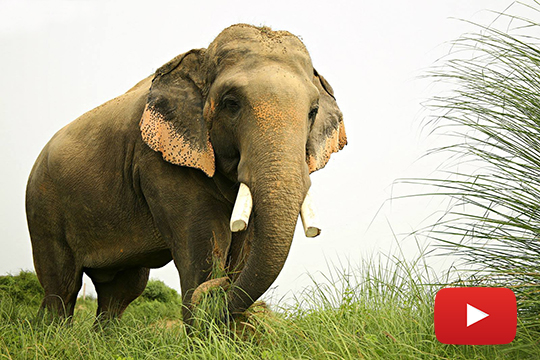Elephant in the Room, Massachusetts State Fair, Yok Don National Park, Snore, Peanut, Wildlife SOS works with Chhattisgarh Forest Department along with their Rescue and Release Highlights!
Here's a quick Friday video comp featuring some of our favorite Wildlife SOS "rescue-and-release" moments! It's got eles and bears and leopards and so much more. Click here or Click the video graphic to watch.
Help Free Elephants Being Abused and Neglected at Massachusetts State Fair! After being horrified at the sad sight of an emaciated elephant named Minnie enslaved at the Big E state fair in West Springfield, Massachusetts, a concerned fairgoer was recently moved to share a photo of the pachyderm on Facebook.
In the few days since the post has gone viral, and animal activists across the country and around the world are calling for an end to the suffering of Minnie and the other wild animals who are currently on display at the Big E. Read more here.
Below is an account of our work with the Chhattisgarh Forest Department to resolve a conflict situation between villagers in the area and a herd of wild elephants. Part of our solution involves radio-collaring members of the herd so that we can track their movements and give farmers and villagers advance notice.
It was hot and muggy with temperatures reaching 110 Fahrenheit when a team of experts from Wildlife SOS and the Chhattisgarh Forest Department arrived in Mahasamund this June. But that wasn't our biggest problem. Dangerous conflicts between several villages in the area and a wild herd of elephants had people on edge. There was even talk of demanding the government capture the herd — removing yet another of India’s dwindling wild elephant populations from the landscape. The team members, comprising elephant ecologists, trackers, veterinary staff, and forest rangers, were there to defuse the situation and protect all involved, elephants and people.
We knew the task ahead was complicated; part of the job involved tranquilizing and radio-collaring three wild elephants (the matriarch of a 10-member herd as well as two large tuskers). No easy feat. Still, even we were surprised when — after days of tough, painstaking work — we still hadn’t been able to collar any of the elephants, partly due to equipment failure in the relentless heat. The upside was that we’d gotten some valuable insight into the specific challenges we’d be facing in these forests. With the safety of this vulnerable elephant herd (as well as our own team) foremost in our minds, we decided to take some time to regroup and modify our plans according to the realities of the field.
Meanwhile, our trackers continued following the elephants through Mahasamund, taking thorough notes on their behavior and movements, then reporting back to us. And then, with the onset of monsoon season, temperatures finally dropped and the elephants began venturing out of the dense forests. This was our chance!
Here is one of the three wild tuskers
 We headed back to Mahasamund on September 17, greeted by the weary yet hopeful faces of the villagers and farmers there. They told us that the level of elephant crop raiding threatened their very livelihoods. But they believed we could help, which proved to be quite a motivation booster for us when seemingly unscalable challenges began popping up.
We headed back to Mahasamund on September 17, greeted by the weary yet hopeful faces of the villagers and farmers there. They told us that the level of elephant crop raiding threatened their very livelihoods. But they believed we could help, which proved to be quite a motivation booster for us when seemingly unscalable challenges began popping up.
First, there was a maddening unpredictability to the weather. Many times our team would head out with full gear and accessories, only to have their plans dashed by bad visibility in the pouring rain. The dynamics of the elephant herd were also confusing at times: sometimes the matriarchal herd and three adult bulls would move together, and other times they would move in opposite ends of the forest. To further complicate things, our veterinarians noticed that one of the bulls was in musth, a kind of “rutting season” for the males when strongly increased levels of testosterone can lead to unpredictable and dangerous behavior.
Given all this, the team decided that it was best to focus on collaring the matriarch. And it seemed as if nature agreed; the field conditions improved vastly on September 22. Thanks to the beaming sun, visibility was good enough for us to track the matriarchal herd with relative ease. At about 3.5 miles (approximately 6 kilometers) from the village of Murumdih, we spotted them at rest, basking in the morning sun. The tranquilization team carefully set up a sedative-laced dart for the matriarch, who we call Van Devi, meaning “queen of the forest.” Once it was administered, all we had to do was wait for the sedatives to kick in.
But Van Devi had other plans. She fought the drug and managed to walk for nearly another full mile (1.5 km). We followed at a safe distance until the sedatives finally started slowing her down. Several team members kept an eye on the herd while others calmly covered Van Devi’s eyes to reduce her anxiety. The team quickly outfitted her with a neck collar, taking care not to compromise the queen’s comfort in any way. The entire procedure took just over an hour, after which we administered an anti-sedative. Needless to say, Van Devi quickly rushed to rejoin her herd, which had been keenly watching the entire procedure from afar. Whew!
Van Devi's eyes are covered during collar fitting to reduce stress
 Our goal is to make sure this herd stays wild and free, and we were able to check one component off the list by radio-collaring Van Devi! Our trackers can now turn their attention to watching the bulls and studying their behavior. Once the rains have subsided (and that tusker is safely out of musth), we'll return to Chhattisgarh to collar them too. In the meantime, we'll keep the crucial work of community engagement going by updating the villagers, addressing their concerns, and answering their questions.
Our goal is to make sure this herd stays wild and free, and we were able to check one component off the list by radio-collaring Van Devi! Our trackers can now turn their attention to watching the bulls and studying their behavior. Once the rains have subsided (and that tusker is safely out of musth), we'll return to Chhattisgarh to collar them too. In the meantime, we'll keep the crucial work of community engagement going by updating the villagers, addressing their concerns, and answering their questions.
We'd like to express a very special thank you to the Chhattisgarh Forest Department, who played an invaluable role in making this phase of the project a success. And, as always, our deepest thanks go you, our supporters. Programs like this one would be impossible without your compassion. If you’d like to continue your support and receive a beautiful, meaning gift in return, please take a look at our Kalandar holiday sale here: https://wildlifesos.myshopify.com/. Each purchase you make helps save wildlife!
Help Free Elephants Being Abused and Neglected at Massachusetts State Fair! After being horrified at the sad sight of an emaciated elephant named Minnie enslaved at the Big E state fair in West Springfield, Massachusetts, a concerned fairgoer was recently moved to share a photo of the pachyderm on Facebook.
In the few days since the post has gone viral, and animal activists across the country and around the world are calling for an end to the suffering of Minnie and the other wild animals who are currently on display at the Big E. Read more here.
Below is an account of our work with the Chhattisgarh Forest Department to resolve a conflict situation between villagers in the area and a herd of wild elephants. Part of our solution involves radio-collaring members of the herd so that we can track their movements and give farmers and villagers advance notice.
It was hot and muggy with temperatures reaching 110 Fahrenheit when a team of experts from Wildlife SOS and the Chhattisgarh Forest Department arrived in Mahasamund this June. But that wasn't our biggest problem. Dangerous conflicts between several villages in the area and a wild herd of elephants had people on edge. There was even talk of demanding the government capture the herd — removing yet another of India’s dwindling wild elephant populations from the landscape. The team members, comprising elephant ecologists, trackers, veterinary staff, and forest rangers, were there to defuse the situation and protect all involved, elephants and people.
We knew the task ahead was complicated; part of the job involved tranquilizing and radio-collaring three wild elephants (the matriarch of a 10-member herd as well as two large tuskers). No easy feat. Still, even we were surprised when — after days of tough, painstaking work — we still hadn’t been able to collar any of the elephants, partly due to equipment failure in the relentless heat. The upside was that we’d gotten some valuable insight into the specific challenges we’d be facing in these forests. With the safety of this vulnerable elephant herd (as well as our own team) foremost in our minds, we decided to take some time to regroup and modify our plans according to the realities of the field.
Meanwhile, our trackers continued following the elephants through Mahasamund, taking thorough notes on their behavior and movements, then reporting back to us. And then, with the onset of monsoon season, temperatures finally dropped and the elephants began venturing out of the dense forests. This was our chance!
Here is one of the three wild tuskers

First, there was a maddening unpredictability to the weather. Many times our team would head out with full gear and accessories, only to have their plans dashed by bad visibility in the pouring rain. The dynamics of the elephant herd were also confusing at times: sometimes the matriarchal herd and three adult bulls would move together, and other times they would move in opposite ends of the forest. To further complicate things, our veterinarians noticed that one of the bulls was in musth, a kind of “rutting season” for the males when strongly increased levels of testosterone can lead to unpredictable and dangerous behavior.
Given all this, the team decided that it was best to focus on collaring the matriarch. And it seemed as if nature agreed; the field conditions improved vastly on September 22. Thanks to the beaming sun, visibility was good enough for us to track the matriarchal herd with relative ease. At about 3.5 miles (approximately 6 kilometers) from the village of Murumdih, we spotted them at rest, basking in the morning sun. The tranquilization team carefully set up a sedative-laced dart for the matriarch, who we call Van Devi, meaning “queen of the forest.” Once it was administered, all we had to do was wait for the sedatives to kick in.
But Van Devi had other plans. She fought the drug and managed to walk for nearly another full mile (1.5 km). We followed at a safe distance until the sedatives finally started slowing her down. Several team members kept an eye on the herd while others calmly covered Van Devi’s eyes to reduce her anxiety. The team quickly outfitted her with a neck collar, taking care not to compromise the queen’s comfort in any way. The entire procedure took just over an hour, after which we administered an anti-sedative. Needless to say, Van Devi quickly rushed to rejoin her herd, which had been keenly watching the entire procedure from afar. Whew!
Van Devi's eyes are covered during collar fitting to reduce stress

We'd like to express a very special thank you to the Chhattisgarh Forest Department, who played an invaluable role in making this phase of the project a success. And, as always, our deepest thanks go you, our supporters. Programs like this one would be impossible without your compassion. If you’d like to continue your support and receive a beautiful, meaning gift in return, please take a look at our Kalandar holiday sale here: https://wildlifesos.myshopify.com/. Each purchase you make helps save wildlife!
VIDEO |
EDITORIAL |




